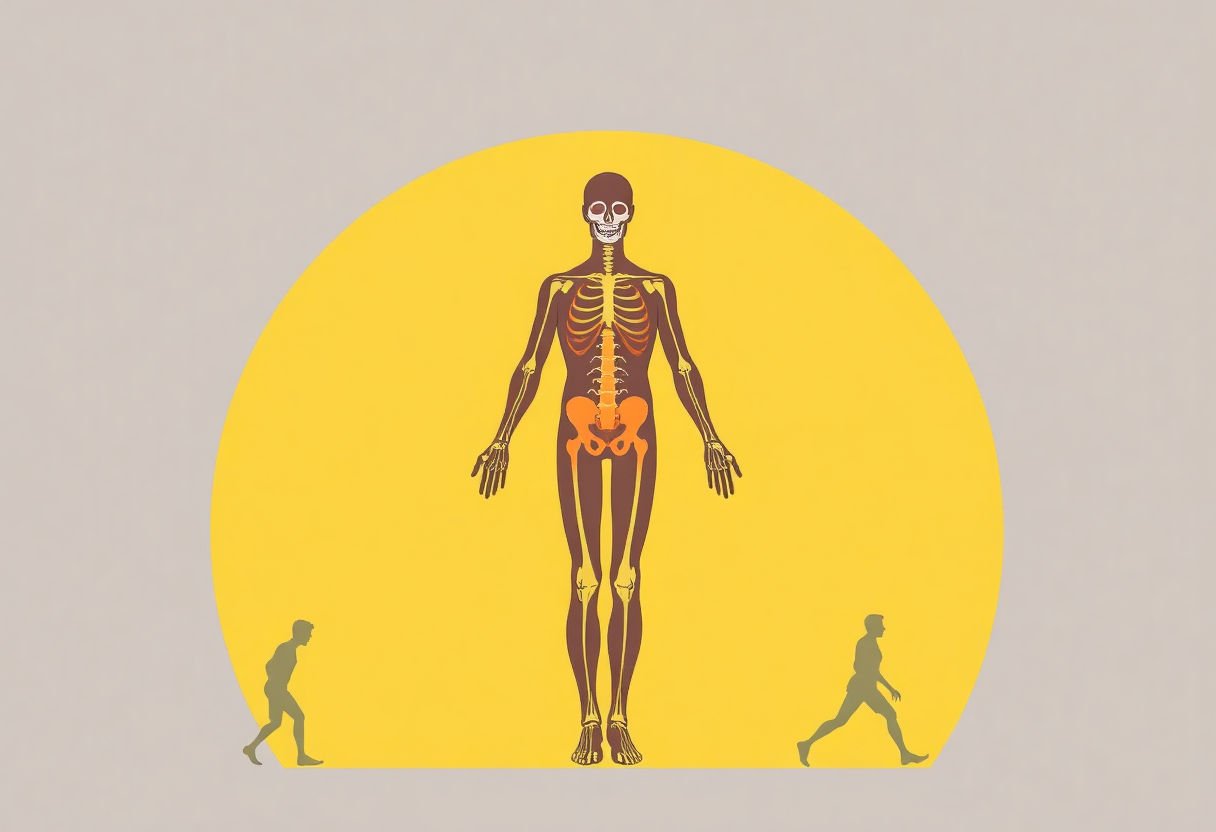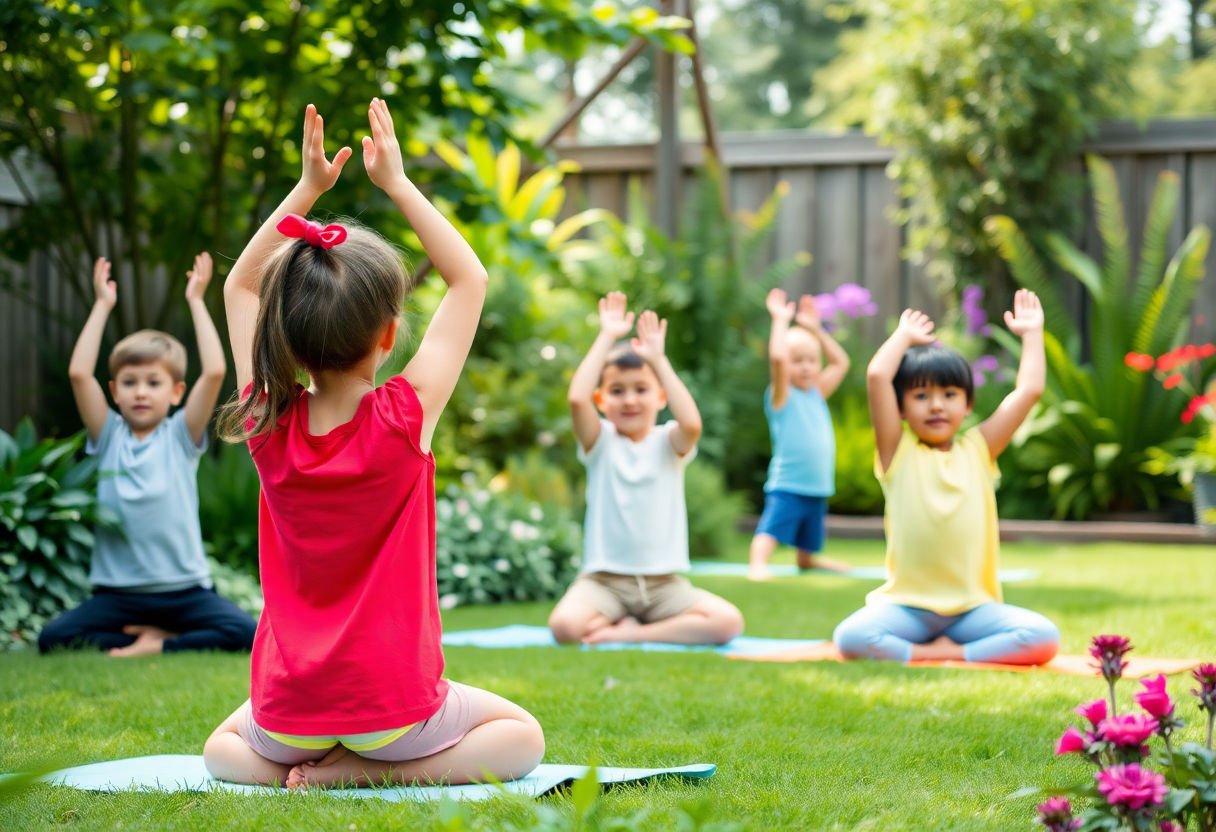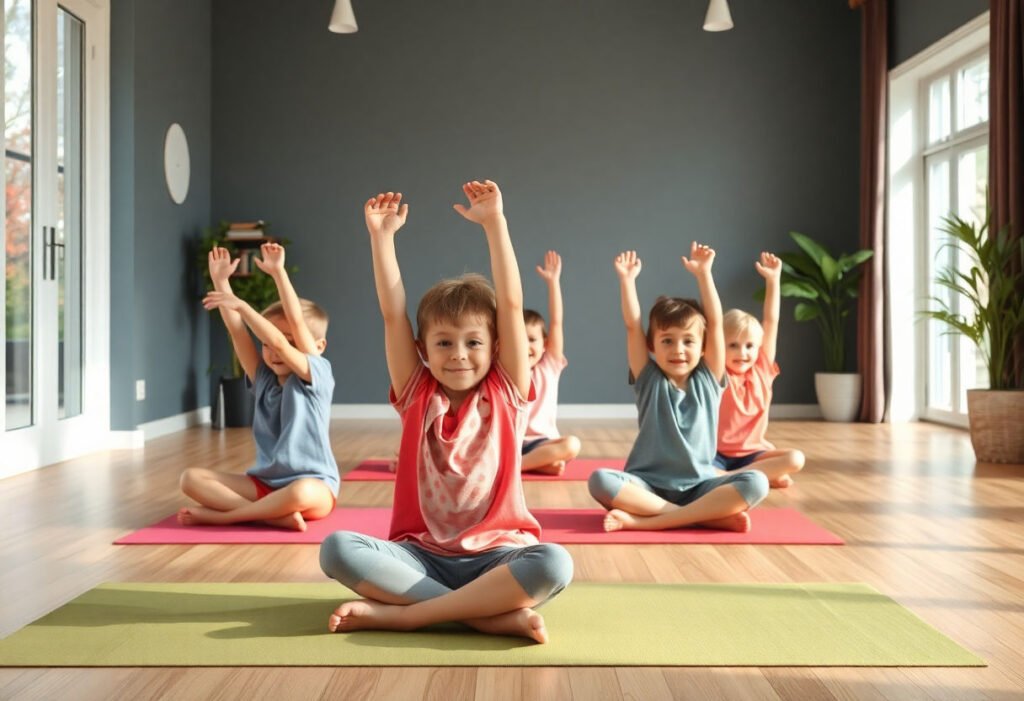The connection between mind and body plays a pivotal role in children’s growth and development. Somatic exercises, which are designed to foster this connection, offer profound benefits for both the physical and emotional well-being of children. Through engaging activities such as breathing exercises, creative movement, and mindfulness techniques, children can enhance their focus, imagination, coordination, and emotional regulation. This article delves into a variety of fun and effective methods tailored to bolster kids’ holistic health, equipping parents and educators with practical strategies to incorporate such exercises into daily routines safely.
Key Takeaways
- Somatic exercises are crucial in enhancing children’s mind-body connection, promoting physical and emotional development.
- These activities foster improved motor skills, coordination, and focus, contributing to overall well-being.
- Engaging in creative movement and mindfulness practices boosts children’s creativity and emotional regulation.
- Yoga and balance exercises tailored for kids offer a playful yet effective approach to cultivating bodily awareness.
- Integrating somatic exercises into daily routines helps nurture a habit of health and mindfulness in children.
What Are Somatic Exercises?

Somatic exercises are mind-body practices designed to improve awareness of bodily sensations to promote overall well-being. These exercises center around the connection between the body and mind, encouraging individuals to become more attuned to their physical experiences. This heightened awareness can lead to enhanced bodily control and emotional stability.
For children, somatic exercises play a crucial role in developing mind-body wellness. Engaging in these activities helps kids cultivate a deeper understanding of their bodies, which is essential for healthy growth and development. By focusing on sensory experiences, children learn to better process and regulate emotions, contributing to a more balanced mental state.
Somatic exercises also emphasize the role of the nervous system in maintaining bodily harmony. Through gentle movements and mindful attention, these exercises encourage the relaxation of muscle tension and promote a state of calm. This is particularly beneficial for children who may experience stress or anxiety, as it provides them with tools to self-soothe and manage emotions effectively.
Additionally, introducing somatic exercises at a young age can foster positive habits that carry into adulthood. Activities might include gentle stretching, guided imagery, or specific movement patterns that focus on bodily sensations. These exercises are non-competitive, making them accessible and enjoyable for children, who can participate without the pressure of achieving specific goals.
Overall, somatic exercises offer a powerful way for children to explore and enhance their mind-body connection, laying the groundwork for a lifetime of health and well-being.
Benefits of Somatic Exercises for Kids
Somatic exercises hold a wide array of benefits for children, enhancing both their physical and mental well-being. At their core, these exercises serve to foster a deep connection between the mind and body, promoting holistic health.
Physical Benefits: Somatic exercises help improve children’s motor skills, such as balance, coordination, and flexibility. By engaging in these activities, kids learn to move with greater ease and control, which can prevent injuries and support healthy physical development. These exercises also enhance strength and endurance, providing a fun and engaging way for children to stay active.
Mental and Emotional Benefits: The advantages extend beyond physical health. By encouraging mindfulness and self-awareness, somatic exercises empower children to manage stress and anxiety effectively. Activities like breathing exercises and mindful movement teach kids how to regulate their emotions and develop resilience, which is crucial for handling everyday challenges.
Cognitive Benefits: Engaging in somatic exercises can also boost cognitive abilities. As children practice movements that require concentration and precision, they also hone their focus and problem-solving skills. This can positively impact academic performance and enhance their ability to engage with complex tasks.
Involving children in somatic exercises helps nurture a lifelong habit of connecting mind and body, aiding their journey to healthy adulthood. As they learn to synchronize their movements with their thoughts, they cultivate a stronger sense of self and an appreciation for the benefits of maintaining their physical and mental health.
Breathing Exercises

Breathing exercises are an effective way to enhance relaxation and focus in children, promoting a deeper connection between their minds and bodies. These exercises are simple yet powerful, and can be easily integrated into daily activities.
One popular breathing technique is belly breathing, which encourages children to breathe deeply from the diaphragm rather than shallowly from the chest. To practice, children should place one hand on their stomach and one on their chest, slowly inhaling through the nose to inflate the belly like a balloon, then exhaling steadily. This technique can help ease anxiety and improve concentration.
Another engaging exercise is balloon breathing. In this activity, children imagine they are inflating a balloon with each inhalation, holding their breath for a moment to maintain the ballon’s size, and then gently letting the air out during exhalation. This visualization not only makes the exercise fun but also supports kids in developing their imaginative abilities while fostering relaxation.
For children who enjoy counting, the 4-7-8 method offers structure. Instruct them to inhale for a count of four, hold the breath for seven counts, then exhale slowly for eight counts. This rhythmic approach helps calm the nervous system and is particularly beneficial before sleep or during stressful situations.
Animal breathing techniques can also capture a child’s interest by incorporating animal sounds and movements. For instance, the “bee” breath involves inhaling deeply then making a buzzing “zzz” sound on the exhale, which can be both calming and amusing for children.
By introducing these breathing exercises, parents and educators can provide children with tools to manage stress, improve focus, and enhance their overall well-being in a playful and engaging manner.
Creative Movement Activities

Incorporating creative movement activities into a child’s daily routine is a powerful way to enhance their mind-body connection. These activities not only spark imagination but also promote physical well-being and self-expression. Engaging in dance is a particularly effective method, as it combines artistry with physical activity. Children can learn to move in rhythm with music, which enhances their coordination and physical awareness.
One imaginative exercise is the creation of a movement story. Children can be guided to narrate a story through body movements, using their imagination to transform into animals, objects, or characters from their favorite tales. This fosters both creative thinking and bodily awareness, as they experiment with various postures and motions.
Another engaging activity is the use of props like scarves, balls, or ribbons. These tools can inspire uninhibited expression as children discover new ways to interact with their environment. Encouraging kids to interpret music or stories with these props can also cultivate their ability to express emotions through movement.
Free-form dance is another effective method, allowing children to explore movement without constraints. This activity encourages self-confidence and individuality, empowering children to express their unique perspectives and emotions.
By routinely integrating creative movement activities, children not only improve their physical dexterity but also boost their self-esteem and emotional intelligence. These activities lay a foundation for a healthy lifestyle and provide children with a nurturing space to explore their innermost thoughts and emotions through the joy of movement.
Balance and Coordination Exercises
Balancing and coordination are crucial aspects of a child’s motor development and overall physical literacy. By focusing on these areas, children can enhance not only their physical abilities but also their cognitive skills and emotional resilience. Here are some enjoyable activities designed to improve balance and coordination.
One accessible activity involves balance beams, which can be easily set up at home or in a classroom using masking tape on the floor. Encouraging children to walk forwards, backwards, or sideways on these lines fosters their concentration and stability. This simple exercise can be gradually modified to include carrying an object or performing turns to increase the challenge.
Additionally, playing games such as “Simon Says” with a focus on balance instructions can enhance both physical coordination and listening skills. Requesting actions like standing on one foot or walking heel-to-toe showcases how coordination exercises can be seamlessly integrated into play.
Jumping activities using hopscotch or small hurdles also promote dynamic balance and coordination. These not only engage their muscles and joints but also require mental planning and sequencing, thus benefiting their cognitive development.
Incorporating yoga poses tailored for children, such as tree pose or warrior pose, can significantly aid in building core strength and balance. These poses are not only effective but can also teach patience and the ability to focus attention, which are valuable life skills.
By making balance and coordination exercises a regular aspect of playtime, children naturally develop a stronger mind-body connection, enhancing their growth across multiple domains.
Mindfulness Techniques for Kids

Mindfulness techniques are essential for enhancing children’s concentration and emotional regulation. By teaching kids to be present in the moment, mindfulness exercises can help reduce stress and increase focus.
One effective technique is guided imagery, where children close their eyes and imagine themselves in a safe, peaceful place. Descriptive scenarios, like a serene beach or a quiet forest, encourage relaxation and mental clarity. This exercise can be particularly impactful for children experiencing anxiety or stress.
Body scanning is another useful approach. This involves guiding children to focus on different parts of their body, noticing any sensations, and releasing tension. Kids can practice this technique while lying down, making it an excellent method for winding down before bedtime.
Mindful breathing is a simple yet powerful technique that can be incorporated into a child’s daily routine. Encourage children to sit quietly and pay attention to their breath, perhaps counting each inhale and exhale. This exercise can easily be practiced before exams or stressful events to foster calmness and composure.
Incorporating mindful listening exercises can also enhance auditory awareness and patience. Children can sit quietly outdoors or indoors and identify different sounds around them, such as chirping birds or distant traffic. This activity cultivates focus and helps children appreciate the environment.
Practicing these mindfulness techniques regularly can lead to improved emotional self-regulation and increased concentration, benefiting children’s overall well-being and academic performance. By integrating mindfulness into their everyday lives, children can develop essential skills for managing emotions and staying focused.
Yoga for Kids

Yoga offers a holistic approach to nurturing children’s physical, mental, and emotional health, making it a brilliant addition to their routine. Introducing yoga to kids can enhance their flexibility, strength, and coordination. Simple poses like Tree Pose and Child’s Pose are excellent starting points, helping young ones develop balance and concentration.
Engaging in yoga practice can also improve focus and clarity, essential skills for academic success and emotional regulation. Children learn to direct their attention and respond calmly to stressors, fostering a sense of inner peace.
Yoga for kids encourages self-discipline and mindfulness through structured activities that require effort and patience. As children master each pose, they build confidence in their abilities. Encouraging children to visualize themselves as animals or objects during poses enhances their imaginative capabilities and keeps the practice fun and engaging.
Additionally, yoga cultivates emotional resilience by providing a safe space for children to explore and understand their feelings. Breathing exercises integrated into yoga sessions teach children how to manage emotions effectively. Techniques such as deep breathing can reduce anxiety and promote relaxation.
Incorporating yoga into the daily routine not only supports a child’s overall development but also strengthens the parent-child bond. Practicing yoga together provides a shared experience, enhancing communication and mutual understanding.
By offering a structured yet flexible form of exercise, yoga encourages children to appreciate their bodies and embrace a healthy lifestyle. This foundational practice lays the groundwork for lifelong wellness habits, empowering kids to thrive both physically and mentally.
Integrating Somatic Exercises into Daily Routine
Integrating somatic exercises into a child’s daily routine can have profound and long-lasting effects on their overall well-being. Consistent practice not only strengthens the mind-body connection but also promotes physical health, emotional regulation, and cognitive focus. Here are some effective strategies for incorporating these exercises into everyday life:
-
Start with Mornings: Begin the day with brief somatic exercises that awaken the body and mind. Gentle stretches or a few yoga poses can set a positive tone for the day. Encourage deep breathing and mindfulness to help children become more aware of their physical sensations and thoughts before starting school or daily activities.
-
Use Transitions Wisely: Incorporate short sessions of somatic activities during routine transitions, such as before meals or between homework tasks. This not only breaks up long periods of sitting but also helps children refocus and recalibrate their attention and energy.
-
Make It Part of Playtime: Transform somatic exercises into playful activities. Children are more likely to engage in exercises that feel like games. Activities such as balancing on one foot, hopping, or imitating animal movements can be both fun and beneficial.
-
Integrate Before Bedtime: Wind down with calming somatic activities like light stretching or body scans. These can ease the transition to sleep by reducing tension and enhancing relaxation.
For educators, these exercises can seamlessly become part of classroom activities. Short five-minute somatic breaks can aid in improving concentration and reducing stress. By embedding these practices into the natural flow of the day, children can experience the myriad benefits of mind-body harmony.
Safety Considerations for Somatic Exercises
When incorporating somatic exercises into children’s routines, ensuring their safety is paramount. Creating a safe environment is the first step. Choose a spacious area free from obstacles to prevent trips or falls during activities. Utilizing padded mats can further cushion falls, adding an extra layer of safety.
Age-appropriate activities are crucial. Tailor exercises to suit children’s developmental stages. Younger children may benefit from simpler movements, whereas older kids can be introduced to slightly more complex exercises. Always focus on exercises that match their physical capabilities and mental readiness.
It’s essential to engage in proper supervision. While somatic exercises are often gentle, adult supervision is necessary to guide children through movements and address any issues that arise. Ensure that supervisors are familiar with the exercises and aware of potential hazards, promoting a secure practice.
Encouraging children to be mindful of their signals of pain or discomfort is also vital. Teach them to voice any discomfort immediately. Remind them that the objective of somatic exercises is to foster relaxation and connection, not to strain or overextend themselves.
Lastly, prioritize hydration and proper nutrition before and after exercises. Encourage children to drink water before starting any physical activity. A light, nutritious snack can maintain energy levels, ensuring that children remain focused and engaged.
These practices collectively ensure that somatic exercises are not only effective but also safely enjoyed, supporting the holistic development of a child’s mind-body connection.
Conclusion
Incorporating somatic exercises into a child’s routine yields profound benefits for their development, fostering a stronger mind-body connection and enhancing both physical and emotional well-being. From breathing techniques to playful yoga, these practices encourage creativity, coordination, and mindfulness. As we witness the positive transformations in children, the future looks promising with the potential for these exercises to become a standard part of education and daily life. Parents and educators are encouraged to embrace these engaging activities, ensuring they cater to the holistic growth of our younger generation, setting a solid foundation for lifelong health and wellness.
Frequently Asked Questions
What are somatic exercises, and how do they benefit children?
Somatic exercises are body-focused activities designed to improve mind-body connection and awareness. They can enhance children’s physical coordination, mental focus, and emotional regulation.
How often should children practice somatic exercises?
For maximum benefit, it’s recommended that children engage in somatic exercises several times a week, even if for just a few minutes each day. Consistency aids in developing long-lasting mind-body awareness.
Are somatic exercises suitable for all age groups of children?
Yes, somatic exercises can be adapted for children of various age groups. It is crucial, however, to tailor activities to the child’s developmental stage to ensure they are both safe and effective.
Can parents easily incorporate somatic exercises at home?
Absolutely, many somatic exercises can be performed at home with minimal equipment, making them accessible for parents to integrate into daily routines. Simple adjustments in household activities can complement these exercises.
What should parents consider to ensure safety during these exercises?
Parents should prioritize a safe space, avoid any activities that cause pain, and supervise younger children during exercises. Ensuring proper guidance and encouraging self-awareness in children can prevent injuries.


